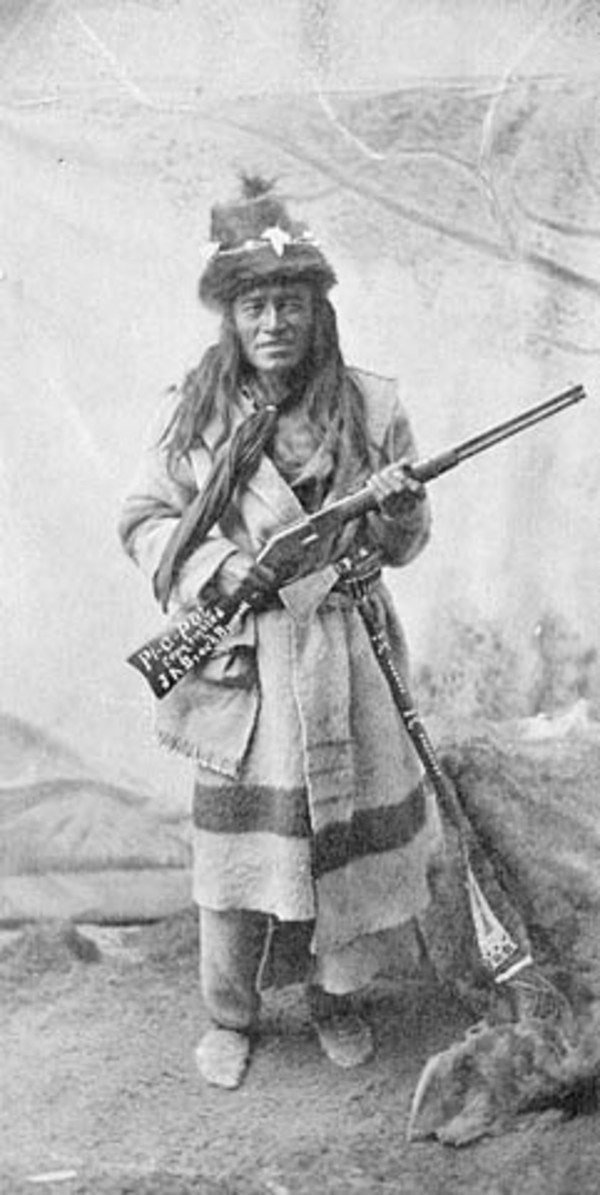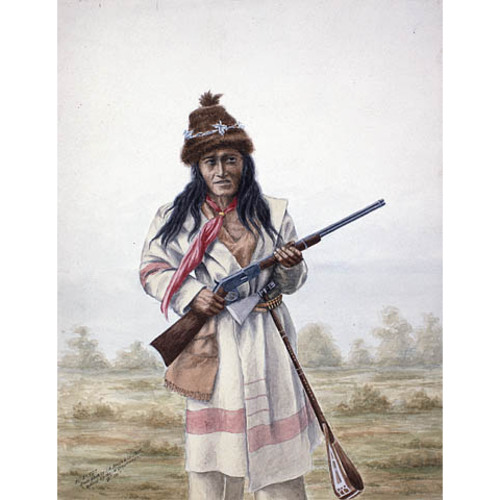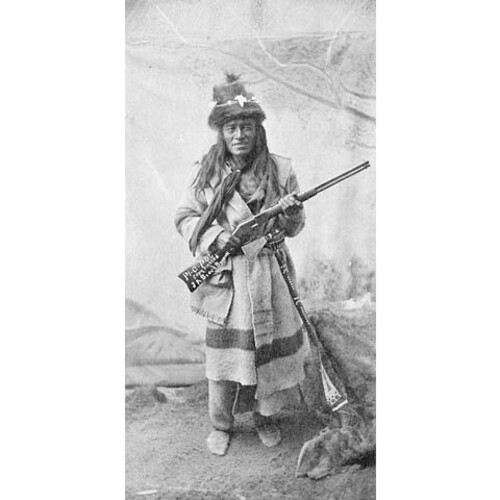PAYIPWAT (Piapot, Hole in the Sioux, Kisikawasan, Flash in the Sky), Plains Cree chief; possibly b. c. 1816, probably in what is now southwestern Manitoba or eastern Saskatchewan; d. in late April 1908 on the Piapot Reserve, Sask.
Originally named Kisikawasan, or Flash in the Sky, Payipwat was one of the five major leaders of the Plains Cree after 1860. While he was a child he and his grandmother were taken prisoner by the Sioux. He grew to manhood among them and learned their medicine. In the 1830s he was captured by the Cree and returned to his own people. Because he knew Sioux medicine, which the Cree believed to be especially powerful, he was then given the name Payipwat, sometimes translated as “one who knows the secrets of the Sioux.” By 1860 he had grown to be a highly respected spiritual leader among the Cree and chief of the Young Dogs, a Cree band which had a large Assiniboin component and frequented Assiniboin territory.
More completely than any other branch of the Cree nation, the Young Dog band had adapted to the buffalo-hunting life of the plains. Its members were notorious as horse thieves and warriors, and because they did little trading had a reputation with the Hudson’s Bay Company as troublemakers. They were among the most feared of the Cree because they had made clear their resentment when in the 1850s the company and the Métis moved into the upper Qu’Appelle River district to compete with the Cree for the diminishing herds of buffalo. Since the buffalo were fast disappearing from Cree territory, Payipwat believed that his people were about to face a severe crisis. He advocated that the Plains Cree expand west into the Cypress Hills, the last major buffalo range touching on Cree lands and one of the last in British North America. Until 1860 the region (now in southwestern Saskatchewan and southeastern Alberta) had been a borderland between the Sioux, Assiniboin, Blackfoot, Blood, and Cree. Because few Indian bands hunted there, the area was a natural refuge for the buffalo. Payipwat and other Cree leaders determined to make it their territory.
Most of the Plains Cree nation took part in the invasion of the Cypress Hills. Although Payipwat played a major role, he refused to participate in what is often regarded as the culmination, an attack on a Blood village near present-day Lethbridge, Alta, late in 1870 [see Jerry Potts*]. The night before, he had a dream that he interpreted as portending disaster but he was unable to dissuade the other leaders from their plan. In this “battle of Belly River,” as it has become known, the Cree lost about one-third of their warriors. The outcome limited them to the eastern portion of the Cypress Hills. The Young Dogs, along with many other Cree and Saulteaux from the Qu’Appelle River region, made that area their home, hunting as far south as the Milk River district of Montana. As a result of their absence from Qu’Appelle, Payipwat was not informed of Canada’s intent to send a commission that would speak to the Cree and Saulteaux people there. He learned of it only after an agreement, Treaty No.4, had been negotiated in 1874.
Payipwat and Cheekuk, the principal Saulteaux leader of the Qu’Appelle district, met treaty commissioner William Joseph Christie* in 1875 at the Qu’Appelle Lakes (The Fishing Lakes). They had with them more than half the Indian people who lived in the region. Payipwat stated that he regarded what had taken place in 1874 as only a preliminary negotiation. To make sure that the Cree were provided with a base from which they could begin agriculture with a reasonable chance of success, he stipulated that the final treaty had to make provision for farm instructors, mills, forges, mechanics, more tools and machinery, and medical assistance. He was assured that these new demands would be forwarded to Ottawa to determine whether they would be put into the treaty, and so on 9 Sept. 1875 he signed the “preliminary” document of 1874.
Payipwat and his people mistakenly believed that the government had agreed to add his conditions to Treaty No.4. In fact, it refused. Most of the terms did become part of Treaty No.6, negotiated in 1876 at forts Carlton and Pitt with the River, House, and Willow branches of the Plains Cree. Moreover, from 1879 the government provided food and farming instruction, not only to the people in Treaty No.6 but also to those in Treaty No.4. These events confirmed Payipwat in his belief that Treaty No.4 had been modified. Because the government never did furnish all that he thought he had negotiated as part of the “Treaty of 1875,” he maintained to his dying day that Ottawa had not fulfilled its promises.
Throughout the 1870s and early 1880s Payipwat was in close contact with the leaders of the River people, Little Pine [Minahikosis*] and Big Bear [Mistahimaskwa*]. These northern leaders, who in the late 1870s were also living in the Cypress Hills, were much concerned that the treaties with Canada would destroy Cree autonomy and culture. They refused to take treaty until clauses guaranteeing autonomy were added and until the agreements made provision for a Cree territory rather than a number of isolated reserves. They believed that a territory on which all the Plains Cree lived would give some protection from governmental interference. Payipwat became the spokesperson among the southern Cree for this movement. He led the people of Treaty No.4 in calling for revisions to provide such a homeland. When Ottawa proved reluctant, in 1879–80 Payipwat, Cowessess [Kiwisānce*], another prominent leader of the southern Cree, Foremost Man [Ne-can-nete*], a minor Cree chief, and the entire Assiniboin nation requested reserves next to one another in the Cypress Hills. The site Payipwat selected in May 1880 was some 37 miles north-northeast of Fort Walsh, the North-West Mounted Police post there. Little Pine and the part of Big Bear’s band that had taken treaty in 1879 under Lucky Man [Papewes] asked for reserves contiguous to either Payipwat’s or the Assiniboin. Ottawa agreed and had the Assiniboin reserve surveyed in 1880. The Indian people were creating a territory that would keep the Assiniboin and Plains Cree united and would enable them to protect their autonomy. What Ottawa declined to do de jure in the treaties was being done de facto by the people in the Cypress Hills.
Their efforts were frustrated by Indian commissioner Edgar Dewdney*. By 1881 he was aware that the huge concentration of Indians had made them an autonomous political entity which neither the police nor the government could control. He believed that he could use the starvation which the people were experiencing with the disappearance of the buffalo to force acceptance of the treaties as written and to prevent the creation of an Indian territory. He was helped, unwittingly, by the Young Dogs and other Cree. In 1881, when they went to the remaining buffalo ranges in Montana, they stole horses from the Crow there and allegedly killed cattle for food. The American army rounded up the Cree, confiscated their guns and wagons, and escorted them back to Canada. Once they were effectively disarmed, Dewdney seized the opportunity. He recommended the closing of Fort Walsh in 1882 and stopped issuing rations until the Cree and the Assiniboin gave up their requests for reserves in the hills and moved north.
Payipwat and the Young Dogs agreed in 1882 to go to the Qu’Appelle River and they were given horses, wagons, and rations for the journey. They did not remain long in the Qu’Appelle region, however. Payipwat claimed to be poorly treated since he was denied what he thought he and his people were entitled to by treaty. He and his Young Dogs returned to the Cypress Hills in September and wintered with Big Bear and Little Pine. The commissioner of the NWMP, Acheson Gosford Irvine, feared violence against the police and attacks on the construction crews of the Canadian Pacific Railway if the Cree were left to starve. He ignored instructions from Ottawa, kept Fort Walsh open, and fed the Cree.
By the spring of 1883 Ottawa had expanded the NWMP. It ordered Irvine to shut down the fort and end rations to Payipwat and the Cree in the Cypress Hills. Weakened by starvation, Payipwat agreed to move to Indian Head and take a reserve beside the Assiniboin, who had moved there early in 1882. To make sure that he actually left, a police escort accompanied him. This event may be the origin of the legendary story of how three police officers kicked down Payipwat’s tepee around him when he attempted to stop construction of the CPR. There is no other record of the police escorting him anywhere, nor is there any mention in the files of the Department of Indian Affairs and the NWMP of an effort by Payipwat to stop the railway or of the police dealing with him on a railway issue.
Payipwat was no sooner out of the Cypress Hills than he attempted to effect a concentration of Indians elsewhere in the Treaty No.4 area. He had originally intended to do so near Indian Head, where he selected a reserve site, but because of the lack of fresh food many of his people died there during the winter of 1883–84. The band, which had numbered over 700 people in 1878, declined to 450 members by 1884. In April that year Payipwat declared that he was moving to the neighbourhood of Fort Qu’Appelle and taking a reserve next to Paskwāw*’s. He also announced that, in preparation, he intended to hold at Paskwāw’s a Thirst Dance and general council of all the Indian leaders of the Treaty No.4 region. He invited Dewdney to the council to discuss treaty revision, but Dewdney refused to attend. He feared that Payipwat was working on a coalition that would promote the establishment of an Indian territory. He therefore sent NWMP commissioner Irvine after Payipwat with orders to break up the council and force him back to Indian Head.
Irvine, with 56 men and a seven-pounder gun, caught up with Payipwat in early May 1884, shortly before he reached Paskwāw’s reserve. When he attempted to arrest the Cree leader in the middle of the night, he found his force surrounded by armed warriors. Rather than risk a battle, he negotiated with Payipwat. Hayter Reed*, representing the Indian commissioner’s office, was present at the talks and was persuaded by Irvine that Payipwat should be permitted to take a reserve beside Paskwāw’s and that the Thirst Dance and council should be allowed to proceed. Dewdney came to believe that unless Payipwat was permitted to settle near Fort Qu’Appelle he would move to the Battleford area and take a reserve next to Little Pine. If that should happen, other Cree from the Treaty No.4 region would follow and Ottawa would be faced in the Battleford district with the Indian coalition and territory that had been so narrowly averted in the Cypress Hills. Dewdney was aware that the movement for treaty revision was growing in strength. Little Pine and Big Bear were promoting the plan among the people of Treaty No.6 while Payipwat was encouraging the Assiniboin, the Saulteaux, and the Touchwood Hills and Rabbit Skin people of the Cree to join him in seeking to have Treaty No.4 modified.
Just when it appeared that the movement was on the verge of success, it was destroyed. The government was able to take advantage of the Métis rebellion of 1885 [see Louis Riel*] to put an end to it. A major military base was established next to Payipwat’s reserve, which was officially surveyed in June 1885. By labelling his associates as rebels, the authorities could use the troops to attack them and bring them to trial as traitors. A brief jail term served to destroy the health of Big Bear and, since Little Pine had died in the spring of 1885, Payipwat was the only leader of the revision movement to survive. He was held in check, first by the troops stationed near his reserve and then by the close surveillance the NWMP kept on him.
Recognized as the major Cree spiritual leader in the south, Payipwat continued to be distrusted by Ottawa in the post-rebellion years since he persisted in promoting Indian culture and was able to make his reserve a homeland for his people. He was feared because of his former contacts with the Sioux and his knowledge of Sioux medicine. The authorities were concerned that he would use his influence to have the Cree participate in the Messiah and Ghost Dance movement that caused so much difficulty on the Sioux reservations in the United States [see Tatanka I-yotank*]. There is, however, no conclusive evidence that he was involved in this movement.
Payipwat came to be regarded as the spokesperson for the traditionalists among the Cree. On his reserve he was able to prevent the government from breaking up the village, the customary form of social organization among the Plains Cree. Ottawa had wanted to atomize the Young Dog band by making its members settle on individual farms scattered over the 54-square-mile reserve. Payipwat refused to allow the land to be surveyed into the 40-acre parcels that would have enabled the government to force the dispersal of the band’s members. As long as he lived, his people resided in the village and practised the Thirst Dance and the Give Away Dance, even though these ceremonies were outlawed in 1892. During the 1890s another 7 square miles was added to the reserve, but it remained well short of the 110 square miles to which the band was entitled by treaty, and to this date there is an outstanding land claim against the Canadian government.
The old leader came under a good deal of pressure after 1900. A new Indian agent, William Morris Graham*, was determined to destroy him and ruin the Indian homeland he had maintained on his reserve. Graham demanded that he be deposed as chief on the grounds of incompetence. In 1902 he had Payipwat arrested for interfering with a policeman engaged in apprehending a suspect on the reserve. When Indian commissioner David Laird*, who had known Payipwat since the 1870s, refused to recognize his behaviour as sufficient grounds for deposition, Graham wanted Payipwat arrested for holding a Thirst Dance. These were better grounds for an attack on his authority. Ottawa deposed Payipwat on 15 April 1902. “I have no doubt he has been too harshly dealt with,” commented Governor General Lord Minto [Elliot*], who met him in September and who tried unsuccessfully to have the ban on dances lifted. “He had been a celebrated old chief for many years – and a great warrior in his time.” Payipwat died on his reserve late in April 1908.
GA, M320, IV, file 45; V, file 57. NA, MG 26, A, 210, 247, 289; RG 10, 3579–940, 7769. Bob Beal and R. [C.] Macleod, Prairie fire: the North-West rebellion of 1885 (Edmonton, 1984). Can., Parl., Sessional papers, 1883, no.5. Isaac Cowie, The company of adventurers: a narrative of seven years in the service of the Hudson’s Bay Company during 1867–1874 . . . (Toronto, 1913). H. A. Dempsey, Big Bear: the end of freedom (Vancouver, 1984). C. E. Denny, The law marches west, ed. W. B. Cameron (2nd ed., Toronto, 1972). Alexander Johnston, The battle at Belly River; stories of the last great Indian battle (Lethbridge, Alta, 1966). J. W. G. MacEwan, Portraits from the plains (Toronto, 1971). D. G. Mandelbaum, The Plains Cree: an ethnographic, historical, and comparative study (Regina, 1979). J. S. Milloy, The Plains Cree: trade, diplomacy, and war, 1790 to 1870 (Winnipeg, 1988). Morris, Treaties of Canada with the Indians. Opening up the west: being the official reports to parliament of the activities of the Royal North-West Mounted Police Force from 1874–1881 (Toronto, 1973). Settlers and rebels: being the official reports to parliament of the activities of the Royal North-West Mounted Police Force from 1882–1885 (Toronto, 1973). Stanley, Birth of western Canada. J. L. Tobias, “Canada’s subjugation of the Plains Cree, 1879–1885,” CHR, 64 (1983): 519–48; “Indian reserves in western Canada: Indian homelands or devices for assimilation,” Approaches to native history in Canada: papers of a conference held at the National Museum of Man, October, 1975, ed. D. A. Muise (Ottawa, 1977), 89–103; “The origins of the treaty rights movement in Saskatchewan,” 1885 and after: native society in transition, ed. F. L. Barron and J. B. Waldram (Regina, 1986), 241–52.
Cite This Article
John L. Tobias, “PAYIPWAT (Piapot, Kisikawasan) (Hole in the Sioux, Flash in the Sky),” in Dictionary of Canadian Biography, vol. 13, University of Toronto/Université Laval, 2003–, accessed April 1, 2025, https://www.biographi.ca/en/bio/payipwat_13E.html.
The citation above shows the format for footnotes and endnotes according to the Chicago manual of style (16th edition). Information to be used in other citation formats:
| Permalink: | https://www.biographi.ca/en/bio/payipwat_13E.html |
| Author of Article: | John L. Tobias |
| Title of Article: | PAYIPWAT (Piapot, Kisikawasan) (Hole in the Sioux, Flash in the Sky) |
| Publication Name: | Dictionary of Canadian Biography, vol. 13 |
| Publisher: | University of Toronto/Université Laval |
| Year of revision: | 1994 |
| Access Date: | April 1, 2025 |





